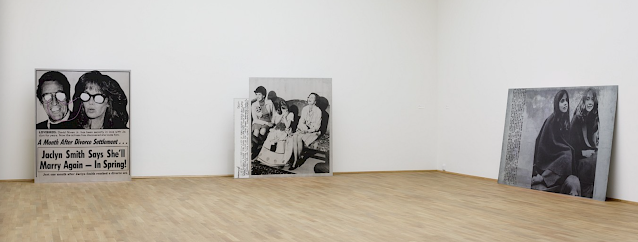Cady Noland
is a postmodern conceptual sculptor and an internationally exhibited installation artist, whose work deals with the failed promise of the American Dream and the divide between fame and anonymity, among other themes. Her work has been exhibited in museums and expositions including the Whitney Biennial in 1991 and Documenta 9 in Kassel, Germany. She attended Sarah Lawrence College and is the daughter of the Color Field painter Kenneth Noland (1924-2010).
Style and Themes
Noland's work often explores what she calls "The American Nightmare," or aspects of American culture she considers toxic, such as social climbing, glamour, celebrity, violence, and death. She describes these social constructs as a "game." Noland's work has dealt with themes of restrictions, both physical and mental, often using metal in her work to evoke senses of joining or separating.
Art Martket
Noland set the record for the highest price ever paid for an artwork by a living woman ($6.6 million), for her 1989 work Oozewald sold at Sotheby's. In the fall of 2012 the same auction house, Sotheby's, removed her aluminum print Cowboys Milking (1990) from a contemporary sale after the artist "disavowed" the work. Both Noland and the auction house were later sued by the piece's owner, gallerist Marc Jancou, for twenty six million dollars (with twenty million having been sought from Noland and six from Sotheby's). In November 2012 a judge dismissed Jancou's lawsuit.
Noland's 1989 red silkscreen on aluminum of Lee Harvey Oswald, titled Bluewald, sold for $9.8 million at Christie's in May 2015, setting a new auction record for the artist.
Noland's central theme in her work retains fear, both personal and cultural. Crashed Car was brought upon by the fact that she was in a car wreck at a very young age. In Plane Crash she emphasizes her fear of flying. The Family and the SLA that kidnapped Hearst is based on her fear of cults. Her newest work has been said to be less aggressive and more friendly to viewers, and more stable and grounded.
Noland's work also studies the American social landscape and shows America's social identity to be in fragments. On top of that, she makes sculptures that are prompted by the theme of humiliation that in part lives in the American consciousness. It is all in relation to the institution, containment and mobility, and to the American way of life.
Noland's arrangement of objects have casualness that call into question the status of the art object and its artistic position. Like other fellow artists, such as Mike Scott and Laurie Parsons, Cady Noland's paintings resist interpretation. Appropriated by Noland, the role of the press photograph expanded in a post-war country that was understanding and exporting itself through images. She is known for reframing the photo that she appropriates through the materiality of the image itself. It is then transferred by silkscreen from source to surface. According to Noland, to reproduce the image is to insert it into a category of knowledge and understanding. One that is transformed by way of a continuous return.
Notable Works
Objectification Process (1989) features a rolled-up flag placed on an orthopedic walker. Noland's incorporation of walkers, canes, police barricades, and fences work to convey themes of immobility, containment, and violence.
In June 2015, the Ohio collector Scott Mueller filed a lawsuit at the United States District Court for the Southern District of New York seeking to reverse his 2014 purchase of Noland's sculpture Log Cabin (1990) for $1.4 million; he claimed that Noland had "disavowed" the work by not approving the extensive restoration of the piece. The artist diavowed her sculpture, following its sale to Mueller, because she believed the work had been restored "beyond recognition." This restoration occurred following a long-term loan to Suermondt-Ludwig-Museum in Aachen, Germany, where the condition of the logs had deteriorated from 10 years of outdoor exposure. A conservator was consulted and hired to complete the restoration in Germany, where all of the decayed wood was replaced with logs obtained from the same Montana source as the original sculpture. The artist, who believes she should have been consulted about this, felt the extensively restored piece was essentially recreated, and therefore, it was now an unauthorized copy of the original, violating her copyright protections as outlined in the Visual Artists Rights Act, a 1990 addition to the US Copyright law.
Since the diavowal in 2016, the artist has been involved in complicated legal battles regarding the restoration of Log Cabin and the application of the copyright laws pertaining to the materials used in her sculpture, German vs. US laws, and her rights to copyright as a living contemporary artist. The most recent lawsuit was dismissed in Jun 2020 by a New York district court judge, who ruled that Noland's rights had not been violated.
























































Comments
Post a Comment